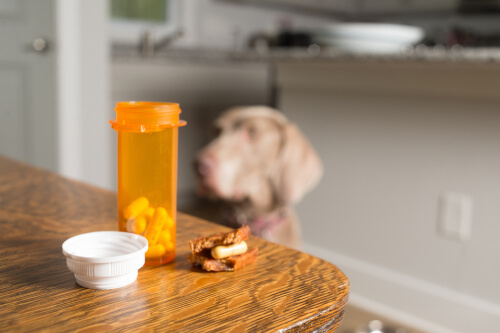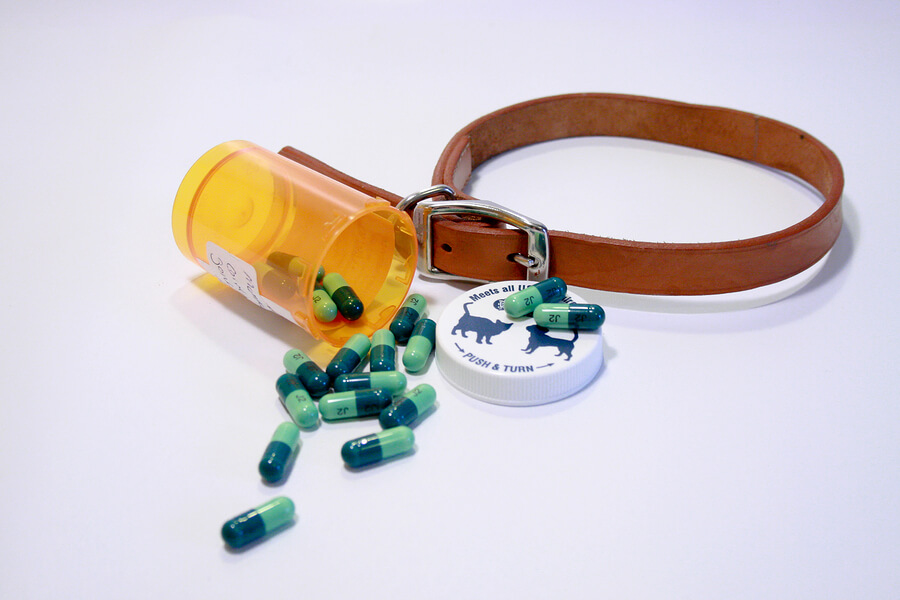The 7 Side Effects of Cortisone in Dogs

Cortisone is a steroid hormone that is used for a wide variety of ailments in humans. It can be administered intravenously, intraarterially, orally, or cutaneously, and its purpose is to depress the immune system, which reduces the inflammatory response and other symptoms associated with diseases. Cortisone can also be used in dogs, but it can have side effects.
If you have visited the vet and your dog has been prescribed this medication, we recommend that you continue reading. Cortisone is a very useful ally in certain medical conditions, but you have to be prepared for the possible side effects that may appear.
How does cortisone work in dogs?
First of all, we need to emphasize that cortisone is the corticosteroid – the active principle – contained in several drugs, but isn’t a drug in itself. We also need to point out that the term “cortisone” often refers to several compounds with similar actions, but which aren’t exactly the same. Among them, we have prednisone, methylprednisolone, dexamethasone and hydrocortisone stand out.
All of these drugs are synthetic glucocorticoids, with functions that resemble those of the steroid hormones produced by the body. Their main task is to depress the immune system – either a human’s or a dog’s – in order to avoid inflammatory processes, autoimmune diseases, asthma or severe allergies.
Among other things, these drugs inhibit the formation of arachidonic acid and eicosanoids (prostaglandins), which are largely responsible for the immediate and non-immediate manifestations of inflammation. They also prevent local vasodilation, which prevents edemas and swellings from forming in the affected areas.
These drugs inhibit the synthesis of substances involved in inflammatory and allergic responses.

What are the side effects?
Any medication has possible side effects, as it disrupts the user’s physiology – either local or systemic – in one way or another. Under this premise, we’re going to list the possible symptoms that a dog may show after the administration of cortisone, either orally, intravenously or cutaneously. Don’t miss it.
1. Immunosuppression
The most important side effect of cortisone in dogs and in other patients is immunosuppression. This drug prevents white blood cells from traveling to the focal point of the infection, but it also reduces the synthesis of some substances that could act as antibodies in the fight against pathogens.
This means that the canid could get infections more easily. As indicated by the VCA Hospitals portal, up to 30% of dogs treated with corticosteroids end up developing urinary tract infections, for example. In addition, these pathologies don’t appear with the common symptoms, as the drug itself prevents itching and inflammation from occurring.
2. Gastrointestinal problems
Corticosteroids can cause intestinal ulcerations and perforations in canids, according to studies. This could be because they increase the production of pepsin (an enzyme in the digestive tract), heartburn, and other mechanisms that damage the stomach lining. For this reason, cortisone is often prescribed along with stomach protectors.
It’s very normal for cortisone in dogs to cause vomiting and diarrhea, apart from the serious effects already mentioned.
3. Delayed wound healing
As indicated by professional portals, corticosteroids can inhibit the synthesis and remodeling of collagen, an essential protein for the maintenance of the skin. Therefore, a dog medicated with this group of drugs may be more prone to superficial wounds remaining on its epidermis for longer.
4. Osteoporosis
In humans, it’s relatively common for osteoporosis to appear as an effect derived from the use of cortisone and other similar drugs. These drugs promote bone decalcification, and, as a result, up to 50% of people on long-term glucocorticoid treatment may have broken bones.
This side effect hasn’t been explored much in the canine world. However, we need to mention it, as a reduction in bone mass has been observed in laboratory animal models.
5. Increased urination and water consumption
Sources already cited argue that corticosteroids can increase the desire to eat, thirst, and, as a result, the rate of urination. Your dog may be more insistent about going outside, as they have to relieve themselves more urgently.
6. Diabetes
Glucocorticoids are known to have an insulin agonist action. This hormone that’s synthesized in the pancreas is very important, as it allows the entry of sugars (glucose) into the animal’s cells, so that it can use them as an energy source. If the action of insulin or its concentration is inhibited, the level of glucose in the blood rises and diabetes appears.
7. Muscle weakness
The decrease in collagen synthesis and the protein anabolism caused by cortisone can also affect the dog’s muscles. Watch how active they are, and if they start slowing down, then make sure you get an appointment with your vet.

Final notes
Everything we have told you may sound rather alarming, but remember that the most serious effects occur in the long term, and not if the dog takes one pill a day for a week. Sometimes, the use of cortisone in dogs is unavoidable, as there’s no other way to treat the immediate symptoms of their condition.
For all these reasons, we recommend that you stick to the vet’s guidelines when treating your dog. If the practitioner sees that the adverse effects outweigh the benefits of the drug, they will choose an alternative route. Never stop the treatment on your own.
All cited sources were thoroughly reviewed by our team to ensure their quality, reliability, currency, and validity. The bibliography of this article was considered reliable and of academic or scientific accuracy.
- Diliz-Perez, H. S., McClure, J., Bedetti, C., Hong, H. Q., De Santibanes, E., Shaw Jr, B. W., … & Starzl, T. E. (1984). Successful small bowel allotransplantation in dogs with cyclosporine and prednisone. Transplantation, 37(2), 126.
- Salaman, J. R. (1983). Steroids and modern immunosuppression. British medical journal (Clinical research ed.), 286(6375), 1373.
- Zarfoss, M., Schatzberg, S., Venator, K., Cutter‐Schatzberg, K., Cuddon, P., Pintar, J., … & Delahunta, A. (2006). Combined cytosine arabinoside and prednisone therapy for meningoencephalitis of unknown aetiology in 10 dogs. Journal of small animal practice, 47(10), 588-595.
- Harkin, K. R., Walshaw, R., & Mullaney, T. P. (1996). Association of perianal fistula and colitis in the German shepherd dog: response to high-dose prednisone and dietary therapy. Journal of the American Animal Hospital Association, 32(6), 515-520.
